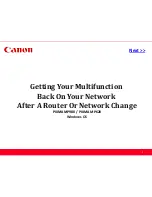
Programmer's Guide
PcOS Series 90PLUS
Communications
Parallel port
12/16/99
Rev M
Page 137
8.2
Parallel Port
8.2.1
Parallel Port Protocol
The Series 90PLUS parallel port behaves just like any printer connected to a personal computer. The
parallel interface accepts 8 bits of data from the host. The strobe signal from the host is used to indicate
that data is available. When the printer sees the strobe signal and has accepted the data, it asserts a busy
signal. The busy signal indicates to the host that the printer has accepted the data and is working on it.
When the printer has been able to absorb the data and is ready to accept another byte, the printer asserts
ACK (acknowledge), negates busy, and then finally negates ACK.
The host computer should meet the following parallel port specifications and timing. In standard PC's, the
strobe signal is generated by software writes to the parallel port control port. This is typically done in the
bios or in some parallel port driver. As personal computers become faster, it is up to the software to assure
that the strobe signal does not get too narrow. One microsecond is about the minimum pulse width that
should be sent down a cable. Shorter pulse widths (500 nanoseconds) will be accepted by the printer;
however, the cable can introduce significant signal degeneration and skew.
It is important that the data be valid before the strobe signal is asserted and remain valid until after the
strobe is removed. A 500 nanosecond setup and hold time is required by the printer.
The following chart illustrates this sequence:
INIT
P in 16
DATA
P ins 2-9
STROBE
P in 1
BUSY
P in 11
ACK
P in 10
<-- Dhld
<--Tstb
Dstu--->
<
>
>
Bhld--->
<
Ahld ---->
<
Sdly ----->
<
Dstu 500 nS (Min)
Dhld 500 nS (Min)
Tstb 1 uS (Min)
Bhld Approx. 5 uS
Ahld Approx. 5 uS
Sdly 3 uS (Min)
Data
Data
< ---- Rdly
Rdly Approx. 2 seconds
<----------------
--------------->
Tcycle
Tcycle 200 - 280 uS Typ.
Figure 24 Parallel port data timing
To implement flow control, the busy signal is asserted by the printer outside the normal data transfer
sequence. The busy signal has several uses, but it always indicates that the printer cannot accept
information. The busy signal may happen at any time and may not adhere to the above timing chart in all
cases. It is up to the host's parallel port driver to handle all possible busy states. It is important that the
host driver does not hang up if it takes some time for an acknowledge (ACK) response to a strobe signal.
Standard personal computer parallel port hardware, implements an interrupt on the ACK signal to make
this task easier.
Summary of Contents for PcOS series 90plus
Page 1: ...P OS c SERIES 90PLUS Receipt Validation Journal Printers PROGRAMMER S GUIDE Rev M PN 100 7586 ...
Page 2: ......
Page 6: ...PcOS Series 90PLUS Programmer s Guide Page iv Rev M 12 16 99 ...
Page 139: ...Programmer s Guide PcOS Series 90PLUS Product Self Tests 12 16 99 Rev M Page 127 73 Italian ...
Page 179: ......
Page 180: ...INSERT PN 100 7307 Rev M 12 16 99 ...
















































